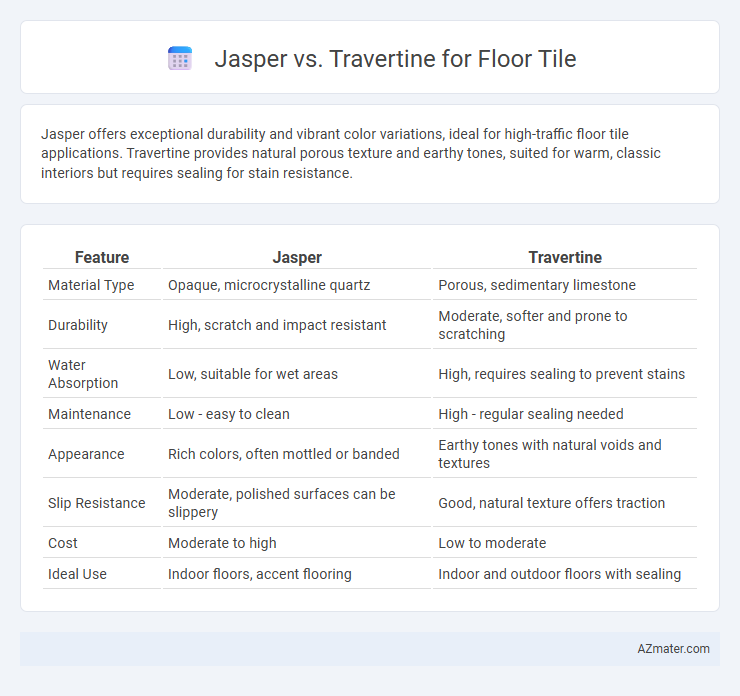Jasper offers exceptional durability and vibrant color variations, ideal for high-traffic floor tile applications. Travertine provides natural porous texture and earthy tones, suited for warm, classic interiors but requires sealing for stain resistance.
Table of Comparison
| Feature | Jasper | Travertine |
|---|---|---|
| Material Type | Opaque, microcrystalline quartz | Porous, sedimentary limestone |
| Durability | High, scratch and impact resistant | Moderate, softer and prone to scratching |
| Water Absorption | Low, suitable for wet areas | High, requires sealing to prevent stains |
| Maintenance | Low - easy to clean | High - regular sealing needed |
| Appearance | Rich colors, often mottled or banded | Earthy tones with natural voids and textures |
| Slip Resistance | Moderate, polished surfaces can be slippery | Good, natural texture offers traction |
| Cost | Moderate to high | Low to moderate |
| Ideal Use | Indoor floors, accent flooring | Indoor and outdoor floors with sealing |
Overview of Jasper and Travertine Tiles
Jasper tiles, formed from cryptocrystalline quartz, offer exceptional hardness and unique, vibrant color patterns ideal for high-traffic floors needing durability and aesthetic appeal. Travertine tiles, a natural sedimentary limestone with porous texture and earthy tones, provide a softer, more classic look suited for traditional or Mediterranean-style interiors but require regular sealing to prevent stains. Both materials present distinct visual and functional characteristics, making the choice dependent on design preferences and maintenance willingness.
Key Differences Between Jasper and Travertine
Jasper is a dense, opaque quartz-based stone known for its vibrant colors and smooth polished finish, making it highly durable and resistant to wear in floor tile applications. Travertine, a type of limestone formed from mineral springs, features a porous surface with natural pits and troughs, offering a more rustic and textured appearance but requiring sealing and maintenance to prevent staining and damage. The key differences lie in Jasper's hardness and uniformity versus Travertine's softer composition and distinctive veining patterns, influencing their suitability for high-traffic areas and aesthetic preferences.
Appearance and Aesthetic Appeal
Jasper floor tiles exhibit rich, earthy tones with intricate patterns that create a warm, natural ambiance, making them ideal for rustic or traditional interiors. Travertine offers a sophisticated, timeless look with its smooth, porous surface and neutral beige or cream hues, adding elegance to both modern and classic spaces. The unique veining and color variations in travertine enhance visual interest, while jasper's bold, multicolored motifs provide a striking focal point in flooring designs.
Durability and Hardness Comparison
Jasper exhibits exceptional durability and hardness, rated around 6.5 to 7 on the Mohs scale, making it highly resistant to scratches and ideal for high-traffic floor tile applications. Travertine, softer with a Mohs rating of approximately 3 to 4, is more prone to wear and requires regular sealing to maintain its surface integrity. For longevity and resistance to heavy use, jasper outperforms travertine as a floor tile material.
Water and Stain Resistance
Travertine is a porous natural stone that tends to absorb water and stains more easily, requiring regular sealing to maintain its resistance. Jasper, a dense and tightly-packed silica-rich stone, naturally offers superior water and stain resistance without frequent sealing. For floor tiles in high-moisture areas, Jasper provides a more durable and low-maintenance option compared to Travertine.
Maintenance and Cleaning Requirements
Jasper floor tiles require minimal maintenance due to their hardness and natural resistance to stains, making them easy to clean with regular sweeping and damp mopping. Travertine tiles demand more care, as their porous surface necessitates sealing to prevent staining and frequent cleaning with pH-neutral cleaners to avoid etching. Both materials benefit from prompt removal of spills, but jasper's durability makes it a lower-maintenance choice for high-traffic areas.
Installation Process and Considerations
Jasper floor tiles require precise cutting due to their hardness, often necessitating diamond-tipped tools and professional installation to avoid chipping. Travertine tiles have a porous nature, demanding thorough sealing before and after installation to prevent staining and water damage. Both materials require a level subfloor and appropriate grout, but travertine's softer composition makes it more prone to cracking under heavy impact during placement.
Suitability for Indoor and Outdoor Flooring
Jasper offers exceptional durability and low porosity, making it ideal for indoor flooring in high-traffic areas due to its resistance to wear and stains. Travertine, with its natural textured surface and ability to withstand varying weather conditions, is highly suitable for outdoor flooring, providing slip resistance and aesthetic appeal. Both stones require proper sealing; Jasper's hardness favors indoor environments while Travertine's porosity and weather resistance make it a preferred choice for patios and walkways.
Cost Comparison and Value
Jasper floor tiles generally cost between $5 and $12 per square foot, offering a durable and visually striking option that can increase home value due to its unique, polished appearance. Travertine tiles, priced around $4 to $10 per square foot, provide a natural, porous texture that requires sealing but adds classic elegance and long-term value to flooring projects. While Jasper tends to be more expensive initially, its lower maintenance and higher durability can result in better overall cost efficiency compared to Travertine over time.
Which is Better: Jasper or Travertine for Floor Tiles?
Jasper offers exceptional durability and resistance to scratches, making it ideal for high-traffic floor tiles, while travertine provides a distinctive, natural texture and a warmer aesthetic that enhances classic or Mediterranean-style interiors. Travertine is more porous and requires regular sealing to prevent stains, whereas jasper's hardness and low porosity reduce maintenance needs and increase longevity. Choosing between jasper and travertine depends on balancing jasper's toughness and low upkeep with travertine's elegant, earthy appearance for your specific flooring requirements.

Infographic: Jasper vs Travertine for Floor Tile
 azmater.com
azmater.com